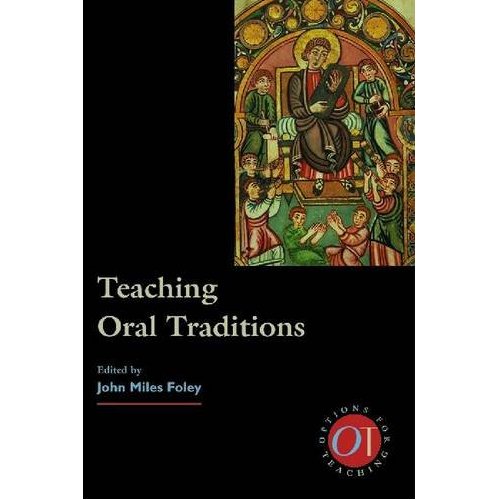 Teaching Oral Traditions. New York: Modern Language Association. A collection of 39 essays (plus an introduction by Foley) centered on the teaching of oral traditions, particularly within the undergraduate classroom. Part I (“Canon or Cornucopia”) consists of four essays that examine how oral traditions fit (or do not fit) into normative modern conceptions of verbal art. Special emphasis is placed on continuities between oral traditions and the Internet (Foley); the need for adapting our ideas concerning comparative literature to include both oral and written traditions (Lee Haring); the confluence of orality, literacy, and gesture within medieval manuscripts (Katherine O’Brien O’Keefe); and the transition of oral traditions into textualized form (Elizabeth Fine). Part II (“Critical Approaches”) then comprises five essays that discuss a particular methodology or methodologies relevant to studying and teaching oral traditions. Rosemary Lévy Zumwalt and Mark C. Amodio provide historical and modern overviews of many of these approaches before specific investigations are made into the Ethnography of Performance (Richard Bauman and Donald Braid), Ethnopoetics (Thomas DuBois), and Traditional Referentiality (Nancy Mason Bradbury). The essays in Part III then demonstrate how these techniques can be employed to teach specific traditions. Covered living traditions include Native American North (Barre Toelken) and South (John H. McDowell), African oral narrative (Donald J. Cosentino), African American (Sw. Anand Prahlad), General Hispanic (John Zemke), Mexican American (María Herrera-Sobek), Jewish (Judith S. Neulander), Indian (R. Parthasarathy), Chinese (Mark Bender), Japanese (Shelley Fenno Quinn), Arabic (Susan Slyomovics), South Slavic (Ronelle Alexander), British-American balladry (John D. Niles), folktales (Steven Swann 704 R. SCOTT GARNER Jones), women’s expressive forms (Marta Weigle), and storytelling (Carol L. Birch). Also covered are texts with roots in oral tradition, including the Hebrew Scriptures (Martin S. Jaffee), New Testament texts (Werner H. Kelber), Homer’s Iliad and Odyssey (Richard P. Martin), Beowulf (Alexandra H. Olsen), Chaucer (Carl Lindahl), the Middle English romance and alliterative tradition (Leslie Stratyner), Old French literature (Evelyn Birge Vitz), the Icelandic sagas (Joseph Harris), and the frame tale (Bonnie D. Irwin). Part IV closes the volume by providing further resources and background for teaching these traditions. A synthesis of a nationwide curriculum survey is presented by Lynn C. Lewis and Lori Peterson; Beverly Stoeltje and Nancy Worthington offer strategies for incorporating issues of multiculturalism within the teaching of these materials; William McCarthy demonstrates how oral traditions can be used beneficially within a composition course; and Anastasios Daskalopoulos offers a selected bibliography of audiovisual and Internet resources meant to assist teachers and students of these traditions. Finally, the collected bibliography that forms the “Works Cited” section of the volume is itself a valuable resource. (责任编辑:admin) |
